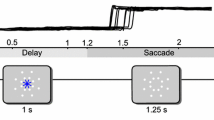Abstract.
We studied the oscillatory activity of the scalp-recorded EEG in healthy humans performing a task that required a particular eye-movement response choice according to the shape of a visual target. We observed a significant stimulus-aligned activity at the 40 Hz frequency band 100 ms after the appearance of the target only when that target was the end point for the subsequent eye movement (pro-saccade). This activity was most prominent over the central-parietal area of the right hemisphere. When the target indicated a movement to the opposite direction (anti-saccade) or indicated that no movement was required (no-move), this 40 Hz activity was nearly absent. This difference in activity between the pro-saccade and the other two tasks was evident in the single subject ERPs for four of the six subjects studied. In contrast, the movement-aligned 40 Hz activity for the pro-saccade and anti-saccade was almost identical. We speculate that this early stimulus-aligned 40 Hz activity might reflect a fast transformation of a visual stimulus to a motor response (eye movement) that can be performed for the pro-saccade task where stimulus-response compatibility is strong compared to the anti-saccade and no-move tasks. The movement-aligned 40 Hz activity might be related to the motor response preparation per se. We conclude that this task specific transient oscillatory activity could be used as a probe in the study of the temporal dynamics of visuomotor transformations.
Similar content being viewed by others
Author information
Authors and Affiliations
Additional information
Electronic Publication
Rights and permissions
About this article
Cite this article
Smyrnis, N., Linardatos, D., Evdokimidis, I. et al. An early transient 40 Hz activity discriminates a following pro-saccade from a no-move and anti-saccade choice. Exp Brain Res 139, 287–296 (2001). https://doi.org/10.1007/s002210100765
Received:
Accepted:
Issue Date:
DOI: https://doi.org/10.1007/s002210100765




